
5 Mechanics
Tinkering with a Basketball Hoop, and a Carnival Ball Game
Mechanics is the area of physics involving force, motion, and energy; in other words, just the sorts of things auto mechanics think about when they try to fix your car. Many of the things you do that are a lot of fun involve serious mechanics: roller coasters, martial arts, fast cars, sports, trampo-lines, pillow fights, etc. Tinkering with mechanics may be tinkering in its most elemental form. Fooling around with some cool gadget, trying to understand it, trying to control it, and make it work better: these are the flesh and blood of tinkering.
Many people shy away from physics due to perceived complexity. The irony is that many truths in physics can be stated in utterly simple form. “Uncle Isaac” Newton laid down three laws of motion that wrap up a lot of mechanics. He said things will stay in their current state—in motion or at rest—until an external force acts on them to bring them out of it. He said the acceleration of an object—how fast its speed changes—depends on its mass and the force it receives. And he said that every action (and by that he meant a push or a pull) has an equal and opposite reaction. Everything that moves follows these rules.
Now that you’re up to date on the physics of mechanics as of 400 years ago, let me just say that these projects comprise some of the most popular of all the tinkering that happens in the Watsonville Environmental Science Workshop. Sending something airborne, even briefly, is what fun is made of. It can be a bit dangerous, perhaps, but since we all know that safety is first, we take all necessary precautions, and no one gets hurt. And once the force, motion, and energy get moving, there are plenty of questions to ponder.
Make: Basketball Hoop
Gather Stuff
• Longish base board, 1" or 2" thick, 3" wide
• Dowel, 5/16" or larger, 1' long or so
• Two 1" boards
• Small block of wood
• Backboard of cardboard or similar stuff
• Plastic bottle neck
• Plastic spoon
• Duct tape
• Small nails
• Thick rubber bands
• Puff ball or similar harmless ball to shoot
Gather Tools
• Saw
• Hammer
• Drill with bit that makes a hole the same size as the dowel
• Hot glue gun with glue sticks
Tinker
The parts list is for the project shown. You should use whatever materials you have sitting around to get basically this arrangement: a bottle neck or any sort of cup as a hoop with a modest court in front of it and an enormous backboard behind to save you endlessly running after the ball. You want the shooter system to be adjustable in at least two ways: the angle and the distance. Here the dowel is hammered into holes drilled in both the base board and the smaller board that the hoop is nailed to. If you can get a drill bit slightly smaller than the dowel—19/64" for the 5/16" dowel, for example—you can hammer the dowel in tightly and not even need glue.
Step 1
Make a court, hoop, and backboard. We painted our project at this step, since we didn’t want the paint to foul up the shooter mechanism.
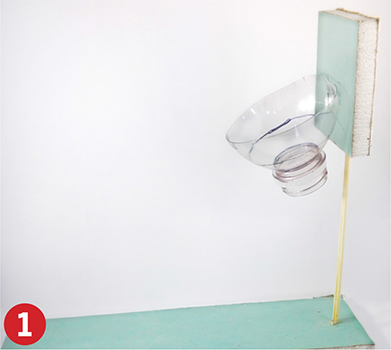
Step 2
Fasten the spoon onto the front edge of the movable wood block with a duct tape hinge.
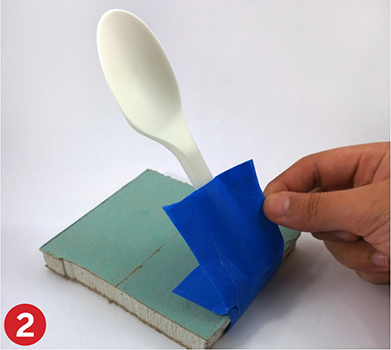
Step 3
Hitch up a movable block behind the spoon to control the shooting angle. We looped the rubber band around the bottom of the block so it could slide back and forth.
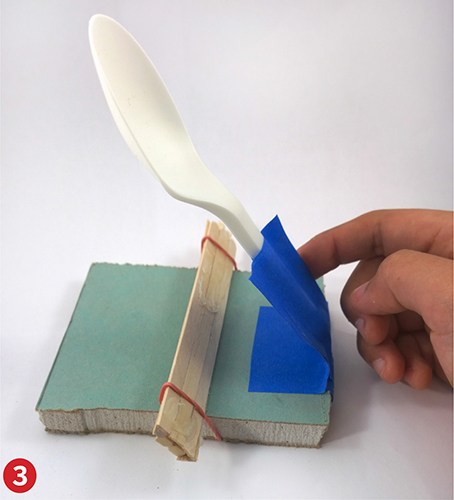
Step 4
Use rubber bands to fasten it to the base board. You’re going to want to slide it back and forth to control the shooting distance.
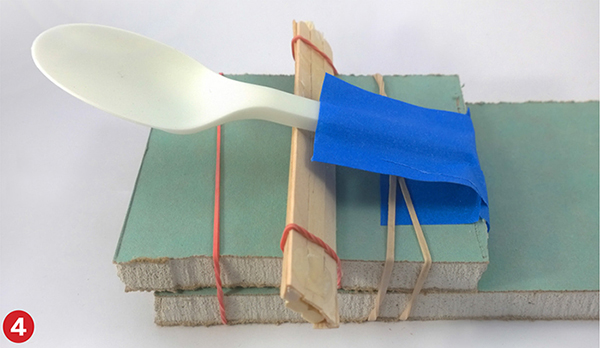
Step 5
Choose your projectile. We like pompom puff balls, since they travel slowly and don’t roll too far, but marbles or paper balls or beans also work. Choose your distance, choose your angle, and shoot some hoops!
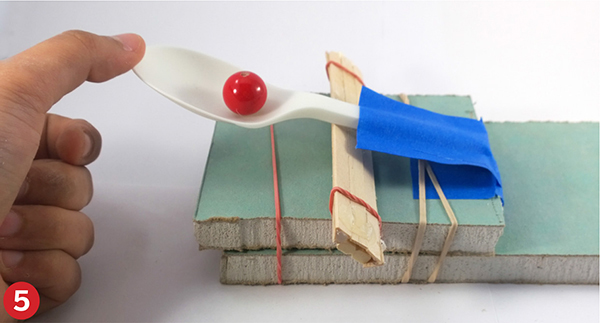
Make: Carnival Ball Game
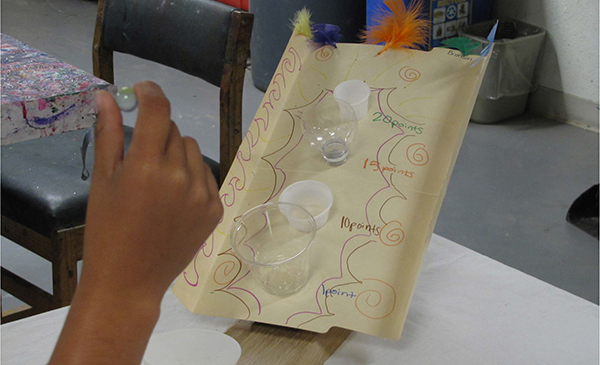
Figure 5-1. Tinkering with the carnival ball game
Gather More Stuff
• Another base board, similar to the first
• Another smaller piece, set at an angle
• File folder
• Small cups or bottle parts
• Rubber glove or balloon
• More rubber bands
• Marble or small ball
• Drywall screws (optional)
Gather More Tools
• Drill and screwdriver bit (optional)
Tinker
Again, it matters not how you slap this thing together. You could even set this whole thing up temporarily propped against a chair or something, with no fasteners at all.
Step 1
We happened to have a beautiful piece of oak trim, scrounged from a local woodworker, so we built ones on that. The other pieces are screwed in, but nails or even glue could be used. The angle shown here, around 30°, works pretty well.

Step 2
And again, the backboard is for ease of play; this one, made from an entire unfolded file folder, makes the marbles roll back to you most of the time. The launcher cup should be sturdy, and you can also mount it on an adjustable block as in the basketball hoop project. The other vessels can be anything you like in any arrangement.
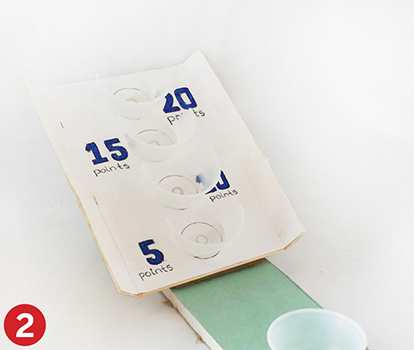
Step 3
The launcher here is really a bouncer. You stretch a latex glove or a balloon over the mouth of the cup, and secure it with a rubber band so it stays tight. Then you bounce your marble off this mini-trampo-line and into the cups ahead. Biggest points for the smallest, farthest cups!

What’s Going On?
Things that go sailing through the air without their own power—cannonballs, footballs, hand-balls, marbles—all follow a path called a parabola. A parabola looks a bit like a rainbow, except that a rainbow is half a circle, with the two ends coming back together at the bottom, which you rarely see in the sky but can easily see with a garden hose misting in the sun shine. A parabola never comes back together and is a bit pointier at the top. It’s one of several shapes called conic sections. They are named that because you can construct them by carefully slicing up an ice cream cone.
So anything soaring without additional power (planes, rockets, birds, and bees don’t count, since they’ve all got an onboard power source) will soon be falling back to the earth following this characteristic shape. There are a couple of exceptions here. One is if an object happens to be going straight up or down. A parabola must have at least a bit of sideways motion. Another exception is that if something hits a certain speed called escape velocity, and is heading upwards, it will never come down. It has freed itself from the earth’s gravitational field. That velocity is around 25,000 miles/hour, so it’s not likely to happen with your marble.
You can start the projectile from any point on the parabola. Think of standing at the lip of the Grand Canyon and kicking a rock straight out over the abyss (terrible idea, by the way: you could kill someone with that rock). The rock will follow a parabola, but only one side of it. In other words, it starts at the tippy-top of the parabola heading forward and then begins the graceful curve downward. If you should pick up a rock and throw it down into the canyon, as opposed to straight forward, again it will follow a parabola, this time starting partway down one of the sides.
Skilled ball players are masters of the parabola. When your favorite sports hero makes a star move, sending the basketball through the hoop from half court, or delivering a Hail Mary pass into the arms of a running back at 80 yards in American football, or slugging the baseball over the left-field fence, what they have done in essence is to send that ball on a parabola that starts with them and ends exactly where they had intended. That is also just the way to win the two games you just built.
The interesting thing is that there is more than one parabola that will do it. In fact, from a given position on the basketball project, there are an infinite number of parabolas extending farther and farther up, each of which returns down into the hoop, swish. To get the different parabolas, you need to change the angle of release and the force given the ball. You change the angle of release by moving the little block behind the spoon, and you control the force of the shot by how far back you pull the spoon. Now, your spindly little spoon will give out before you can try them all (and it’s always a bit of a chore to try an infinite number of things; takes forever), but you can try a few.
See if you can shoot your ball with a low, broad parabola into the hoop and also a high, pointy one, all from the same position.
If you’re using a puff ball, you may notice that the path it follows is somewhat parabolic but not symmetric. It’s flatter on the far side. This is because it has a huge amount of air friction and a very low mass, so the air slows it down quite a lot. The air will slow down a Ping-Pong ball and a paper wad as well, for similar reasons. Marbles will follow much more of a true parabola, since the mass-to-air-friction ratio is much bigger. Marbles and hard things are a bit more dangerous though, so be careful.
Sports players have to consider the air friction factor, and sometimes there is a wind factor, too, taking the ball in a certain direction. Have you noticed that when watching or playing a ball game?
In the carnival game, you’ve got two parabolas, joined at the bounce. The first one starts in your hand, and the second one ends in one of the target cups (if you’re good). It’s harder to analyze, since you have to use the fast-moving marble instead of the puff ball, but it’s also more fun. You can envision a real crackerjack player winging that marble down into the glove, it rebounding up to the ceiling and back down—chup—right into the cup. All following a parabola.
The factors you’d have to master to get this to happen are quite a few. Some are the strength of your throw (which will determine the speed of impact into the glove), the exact point of contact on the glove (you get different bounces when it lands in different places), the angle of impact onto the glove (to a rough approximation the angle of impact will equal the angle of reflection, just like for light in a mirror), and the weight of the ball (a steel bearing will have around four times the mass as the marble, and thus receive a different acceleration from the glove, just as Uncle Isaac said). Tweaking all these factors I believe is what makes it so much fun.
Keep On
Pinball machines (Figure 5-2) and marble rolls are great mechanics projects as well. With these games you’ve still got gravity pulling, but the inclined plane with its obstacles designates the path. In the photo here, you can see the narrow launching chute on the right ending at the top in a curved path that lets the ball out left to fall through the spinners, ramps, traps, and levers until it falls into a slot at the bottom. We’ve made a lot of great marble rolls with just nails or just chunks of wood glued on a slab, but the coolest ones we’ve made were when we could find some little bells for the marble to ding.
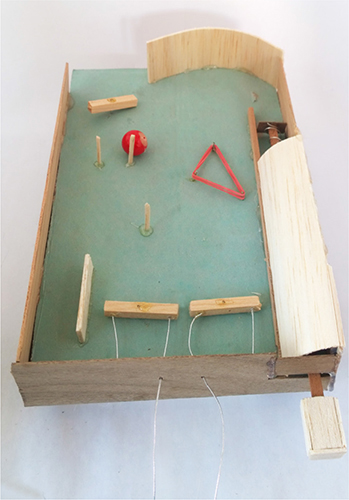
Catapults and trebuchets are glorious subjects for tinkering. Tinkerer’s heaven is filled with them, in all shapes and sizes. Catapults are powered by something stretchy; in Figure 5-3 and Figure 5-4 it’s a rubber band. Two designs here launch the projectile when the throwing arm hits the stop. The throwing arm in Figure 5-3 slides back and forth so that you can designate the angle you want to release from. (The throwing arm swings up between two upright dowels, stopping upon contact with the cross piece at the top.) The model in Figure 5-4 can be adjusted, too, by tilting the whole base backwards. When it is sitting flat, it releases at 0°, straight ahead. With either of these two beauties you can reprove Galileo’s mathematical calculation that a 45° release angle will lob your pebble the farthest distance.
Trebuchets use only gravity to hurl their projectile. This was a big advantage back in the heyday of siege warfare, since there were no good sources of enormous rubber bands back then. The model shown in Figure 5-5 and Figure 5-6 has a water bottle full of water as the weight. When it falls, the long dowel swings up. Trebuchets have trickier holding and release systems for the projectile. In our model, the projectile is a steel nut. We hook it on a string about 0.5 meters long, and loop the string around the hook at the end of the dowel (Figure 5-7). When the weight is allowed to fall, the arm accelerates up, pulling the string with nut in a graceful arc, faster and faster, until the loop slips off the hook. The angle of the hook is key, as is the length of the string. It may take you a while to get it all right. On a good day, this ancient weapon can chuck the nut the full length of our basketball court (the real one, not the earlier project). If you’ve got tinkering blood in your veins, you’re already scaling this one up in your mind, so let me tell you that the best time of year to make a giant one of these is right after Halloween, when you can get all the free pumpkins you want to send sailing across the field.

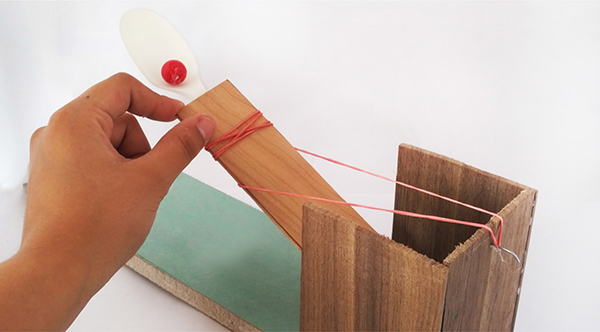
Figure 5-4. A catapult with adjustable throwing arm
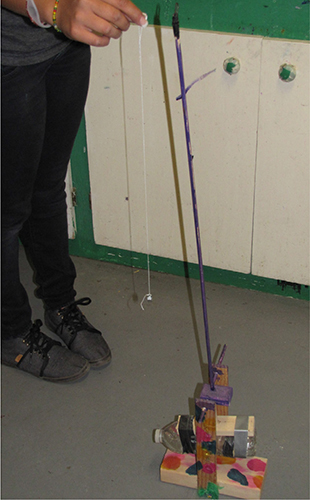
Figure 5-5 A trebuchet with water weight

Figure 5-6. Close-up of the trebuchet
And finally, if you’re going to go to the trouble to launch something up, you may as well put a parachute on it so it will have a nicer ride back down (Figure 5-8). Parachutes made from cloth or plastic occupied a significant portion of my youth. I even made one out of my blanket in second grade and was fortunate enough to let Mom in on my plan to try it out on myself from the peak of our roof. She managed to convince me that this particular project may compromise my entire future. I stuck with little action figures from then on.

Internet Connections
• Base jumping looks like a real scream on YouTube, until you think about what happens when the parachute doesn’t open right.
• Check out the siege weapons in the movie The Lord of the Rings: The Return of the King movie: search “Siege of Gondor, Minas Tirith.” Oh, and it always help to have colossal ogres on hand to reload and cock your trebuchet.
• And have you considered putting this book down to watch a good hour or so of You-Tube trebuchet launches? Look specifically for the floating arm trebuchet (FAT). These monster machines have an initial phase where the throwing arm together with the massive weight fall freely for 10 or 20 feet, building up speed and momentum before the rotation phase kicks in. Don’t get in the way. It looks like some of them could bring a projectile close to escape velocity.
• In fact, you could blow the whole weekend searching things like “best basketball moment of all time” or “awesome football completions.” Watch those parabolas: oooooo...
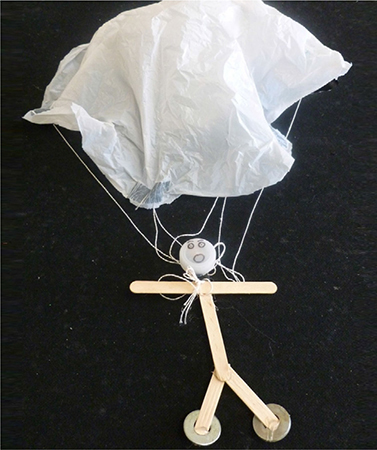
Standards Topics Links
• Mechanics, dynamics, motion, movement, momentum, force, gravity, projectile, parabola, conic sections, simple motion equations, free fall, friction, and inclined plane.
More Tinkering with Mechanics
• Mike Rigsby, Amazing Rubber Band Cars: Easy-to-Build Wind-Up Racers, Models, and Toys (Chicago Review Press, 2007)
• William Gurstelle, Backyard Ballistics: Build Potato Cannons, Paper Match Rockets, Cincinnati Fire Kites, Tennis Ball Mortars, and More Dynamite Devices (Chicago Review Press, 2012)
• Judith Conaway, Things That Go! How to Make Toy Boats, Cars, and Planes (Troll, 1987)
